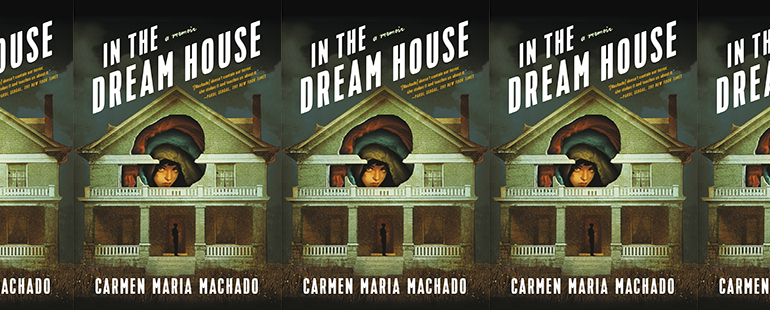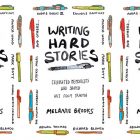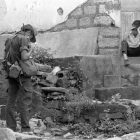In the Dream House by Carmen Maria Machado

In the Dream House
Carmen Maria Machado
Graywolf Press | November 5, 2019
How do you tell a story you don’t have the language for? So many queer stories fall into this space of elusiveness. They don’t fit into expected forms or structures, and many queer writers must be inventive to tell the true shape of their experience. As Carmen Maria Machado discusses in a recent interview with Jera Brown in Poets and Writers, “There is something so interesting about this element of what it means when the person abusing you is another woman, and you’ve been taught that lesbian relationships are egalitarian and sort of a paradise. Or what are you looking at when the person abusing you is one hundred pounds lighter than you or six inches shorter?”
In her new memoir, In the Dream House, Machado tells a story of abuse that often goes unrecognized, exploring what happens when we don’t have ready narrative models for our experiences. In her previous book, the short story collection Her Body and Other Parties, Machado explores the spaces between what we call “realism,” “fantasy,” and “literary,” troubling the boundaries we erect between genres. Here, in her memoir, Machado disrupts genre boundaries even more directly. In short chapters, she moves her tale from one story model to another. From the mythic to the domestic, the horror story to the “Choose Your Own Adventure,” In the Dream House is a shapeshifter of a book. Machado cites the Stith Thompson Motif-Index of Folk-Literature—lists that classify story structures, events, symbols, characters—to tell a story that doesn’t fit the types of abuse stories most of us are familiar with. She reaches for stories we know and will find familiar to tell a story we don’t know and might not believe. She moves from genre to genre, trying to find a shape we will recognize and, in the process, puts the very notion of genre, of narrative shape, of all that we think we know about the nature of story, into question.
The main plot of In the Dream House follows Machado during her time at the Iowa Writers’ Workshop, when she dated a woman who is also a writer, pursuing an MFA in Indiana. The relationship turns increasingly abusive and isolating as Machado regularly drives the hours-long distance to the house she shares with her girlfriend. Machado paints the house as both cozy and sinister, exploring the ways that homes can be both creatively protective and spaces that hold and hide violence, shielding it behind their walls. One night, when her girlfriend chases her threateningly around the house, Machado locks herself in the bathroom, which becomes both a shelter and triggering space: “I could sit there on the floor and cry and say anything I liked because in that moment it was my own little space, even though after that it would never be mine again. For the rest of my time in the Dream House, my body would charge with alarm every time I stepped into that bathroom; but in that moment, I was the closest thing I could be to safe.”
The memoir traces the psychological landscapes of abuse. “In the pit of it,” Machado writes, “you fantasize about dying. . . . Anything to make it stop. You have forgotten that leaving is an option.” A “Choose Your Own Adventure” chapter brilliantly demonstrates the labyrinthine shapes that abuse can create, a trap in which no choice is the right one. As the relationship isolates Machado, taking her both physically and psychologically away from her friends and community, the memoir explores the effects that our friends, families, and communities have on the stories that shape us. Machado dips into the family and social histories that both she and her girlfriend experienced leading up to the relationship, invoking moments from Machado’s future in which family, friends, and her wife have helped her reclaim her story.
In the Dream House has been called a speculative memoir, an emerging term for an in-between form that incorporates fantastical elements into creative nonfiction. Machado’s memoir is the most recent addition to a genre that includes work written by queer and trans authors like Kai Cheng Thom and Ariel Gore, and published by small publishers such as Metonymy Press and Feminist Press. The genre can be particularly useful for stories of marginalized experience, its fluid boundaries allowing space for story shapes that do not fit mainstream literary expectations. It prioritizes the realities of emotional and psychological experience to physicalize internal states, to assert our perceptual experiences as real. For this reason, in the memoir, Machado can, as in Alice’s Adventures in Wonderland, cry a pool of tears so big that she must swim in it, and shrink on a visit to the Art Institute of Chicago: “Small, and then even smaller, and soon you find yourself paddling in your own tears, again.” She can experience the symptoms of a mystical pregnancy or see her own story in the story of Bluebeard. These fantastical and fantastically adjacent moments feel both familiar and unfamiliar. They include very specific descriptions of place and time, creating an emotional resonance that most of us will be able to recognize, while also creating a sense of disjunction—when what we tend to call realism collides with what we tend to call fantasy, as a woman’s emotions quite literally change the physical reality in the book.
In the Dream House shifts into the fantastical in heightened states—in the intensities of coming together, in moments of breaking and break-up, and in discussions of queerness. For Machado, queerness might be described as a kind of in-betweenness, a kind of “both and neither” state of multiplicity: “This is the curse of the queer woman—eternal liminality. You are two things, maybe even more; and you are neither.” But curses are magical and, even as they isolate their bearer, they also give them power. In the end, that’s how Machado’s memoir feels: an assertion of power through a claiming of story.



